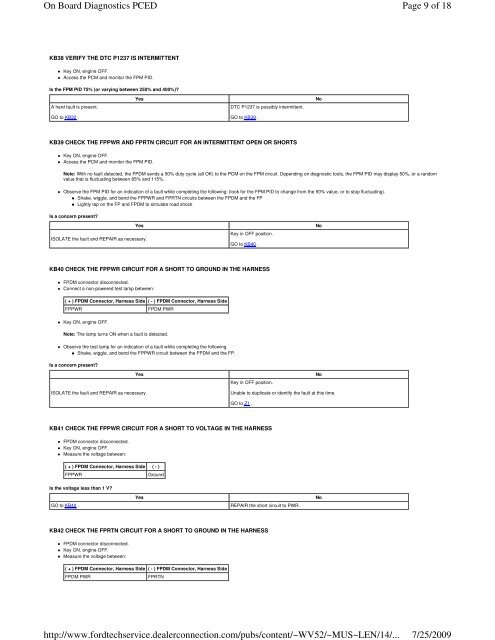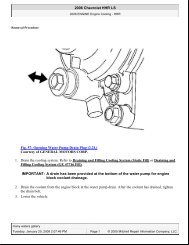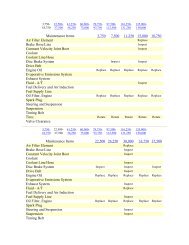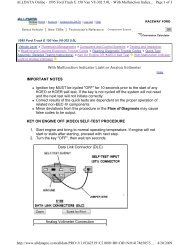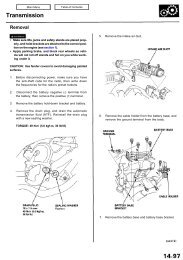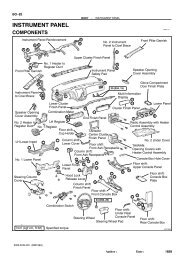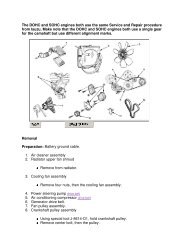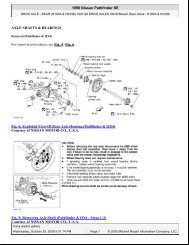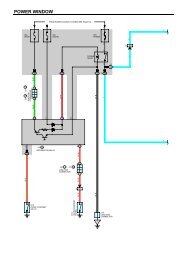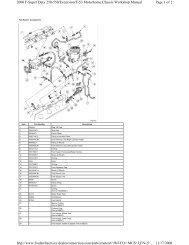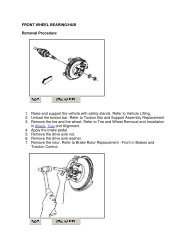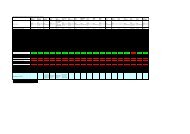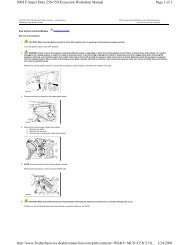Page 1 of 18 On Board Diagnostics PCED 7/25/2009 http://www ...
Page 1 of 18 On Board Diagnostics PCED 7/25/2009 http://www ...
Page 1 of 18 On Board Diagnostics PCED 7/25/2009 http://www ...
You also want an ePaper? Increase the reach of your titles
YUMPU automatically turns print PDFs into web optimized ePapers that Google loves.
<strong>On</strong> <strong>Board</strong> <strong>Diagnostics</strong> <strong>PCED</strong><br />
<strong>http</strong>://<strong>www</strong>.fordtechservice.dealerconnection.com/pubs/content/~WV52/~MUS~LEN/14/...<br />
<strong>Page</strong> 9 <strong>of</strong> <strong>18</strong><br />
7/<strong>25</strong>/<strong>2009</strong><br />
KB38 VERIFY THE DTC P1237 IS INTERMITTENT<br />
Key ON, engine OFF.<br />
Access the PCM and monitor the FPM PID.<br />
Is the FPM PID 75% (or varying between <strong>25</strong>0% and 400%)?<br />
A hard fault is present.<br />
GO to KB32 .<br />
Yes<br />
DTC P1237 is possibly intermittent.<br />
GO to KB39 .<br />
No<br />
KB39 CHECK THE FPPWR AND FPRTN CIRCUIT FOR AN INTERMITTENT OPEN OR SHORTS<br />
Key ON, engine OFF.<br />
Access the PCM and monitor the FPM PID.<br />
Note: With no fault detected, the FPDM sends a 50% duty cycle (all OK) to the PCM on the FPM circuit. Depending on diagnostic tools, the FPM PID may display 50%, or a random<br />
value that is fluctuating between 85% and 115%.<br />
Observe the FPM PID for an indication <strong>of</strong> a fault while completing the following: (look for the FPM PID to change from the 50% value, or to stop fluctuating).<br />
Shake, wiggle, and bend the FPPWR and FPRTN circuits between the FPDM and the FP<br />
Lightly tap on the FP and FPDM to simulate road shock<br />
Is a concern present?<br />
Yes<br />
ISOLATE the fault and REPAIR as necessary.<br />
Key in OFF position.<br />
GO to KB40 .<br />
No<br />
KB40 CHECK THE FPPWR CIRCUIT FOR A SHORT TO GROUND IN THE HARNESS<br />
FPDM connector disconnected.<br />
Connect a non-powered test lamp between:<br />
( + ) FPDM Connector, Harness Side ( - ) FPDM Connector, Harness Side<br />
FPPWR<br />
FPDM PWR<br />
Key ON, engine OFF.<br />
Note: The lamp turns ON when a fault is detected.<br />
Observe the test lamp for an indication <strong>of</strong> a fault while completing the following.<br />
Shake, wiggle, and bend the FPPWR circuit between the FPDM and the FP.<br />
Is a concern present?<br />
Yes<br />
Key in OFF position.<br />
No<br />
ISOLATE the fault and REPAIR as necessary.<br />
Unable to duplicate or identify the fault at this time.<br />
GO to Z1 .<br />
KB41 CHECK THE FPPWR CIRCUIT FOR A SHORT TO VOLTAGE IN THE HARNESS<br />
FPDM connector disconnected.<br />
Key ON, engine OFF.<br />
Measure the voltage between:<br />
( + ) FPDM Connector, Harness Side ( - )<br />
FPPWR<br />
Ground<br />
Is the voltage less than 1 V?<br />
GO to KB42 .<br />
Yes<br />
REPAIR the short circuit to PWR.<br />
No<br />
KB42 CHECK THE FPRTN CIRCUIT FOR A SHORT TO GROUND IN THE HARNESS<br />
FPDM connector disconnected.<br />
Key ON, engine OFF.<br />
Measure the voltage between:<br />
( + ) FPDM Connector, Harness Side ( - ) FPDM Connector, Harness Side<br />
FPDM PWR<br />
FPRTN


